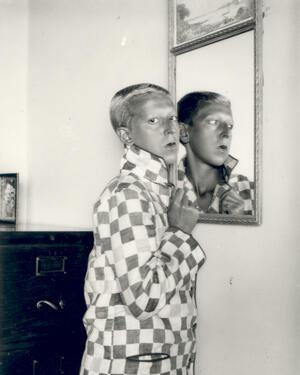Surrealist Photographer Claude Cahun is Born
On October 25, 1894, queer Jewish Surrealist photographer and writer Lucy Schwob, who later adopted the name Claude Cahun, was born in Nantes, France. Cahun would later participate in Paris’ Surrealist movement in the 1920s and 1930s, creating photographs and written work that challenged binary ideas of gender, sexuality, and the self. In a time when queer theory as it is understood today did not yet exist, Cahun’s work was largely sidelined and unacknowledged by the time of her death in 1954. However, since the 1990s, art historians, feminists, and the LGBTQ+ community have come to recognize Cahun’s body of work as a powerful and relevant examination of self-identity.
Cahun was born into a prominent Jewish intellectual family. Her father owned a newspaper and her uncle, Marcel Schwob, was a significant writer in the Symbolist movement. While growing up in Nantes, she met Suzanne Malherbe, who would later adopt the pseudonym Marcel Moore for her work as an illustrator and designer. The two began a romantic and artistic partnership that lasted decades and sparked conversation about lesbian identity among the group of Surrealist artists Cahun and Moore knew.
After studying at the University of Paris, Sorbonne, Cahun settled in Montparnasse with Moore in the early 1920s and began her artistic career. It was in Paris that Cahun adopted the name Claude, which in French is both a male and female name. In Cahun’s time, gender-nonconforming pronouns were not in popular use, so scholars refer to her with the female pronouns she used in her lifetime but acknowledge that she expressed a gender-nonconforming identity; she wrote in her book Disavowals, “Masculine? Feminine? It depends on the situation. Neuter is the only gender that always suits me.”
Cahun’s photography, for which she is best known today, questioned gender identity as well. Cahun posed for self-portraits in a variety of male and female styles and often employed mirrors and other tools in her photography to allow multiple Claudes—sometimes styled differently or using different body language—to address one another within the photograph. As she played with self-presentation, Cahun challenged prevailing notions of binary gender and sexual identity and allowed the viewer to witness her own complex experience of self-identification.
In 1938, with the threat of fascist occupation of France looming, Cahun and Moore fled Paris for Jersey. After the Nazis occupied Jersey, the pair embarked on a dangerous resistance operation. They forged letters from a German soldier, “the soldier with no name,” that expressed disappointment with leadership and said the war had been lost. Cahun and Moore placed these letters in uniform pockets at the laundry, cigarette packs, and under windshield wipers, hoping to foment discontent among German troops. They were ultimately arrested and imprisoned in 1944 and released in 1945 when the war ended. Cahun died nine years later, in 1954. Moore took her life in 1972 and is buried in Jersey under a single gravestone with Cahun, inscribed with two Stars of David.
Sources:
Bower, Gavin James. “Claude Cahun: Finding a Lost Great.” the Guardian, February 14, 2012. https://www.theguardian.com/books/2012/feb/14/claude-cahun-finding-great.
Treaster, Joseph B. “Overlooked No More: Claude Cahun, Whose Photographs Explored Gender and Sexuality.” The New York Times, June 19, 2019, sec. Obituaries. https://www.nytimes.com/2019/06/19/obituaries/claude-cahun-overlooked.html.



